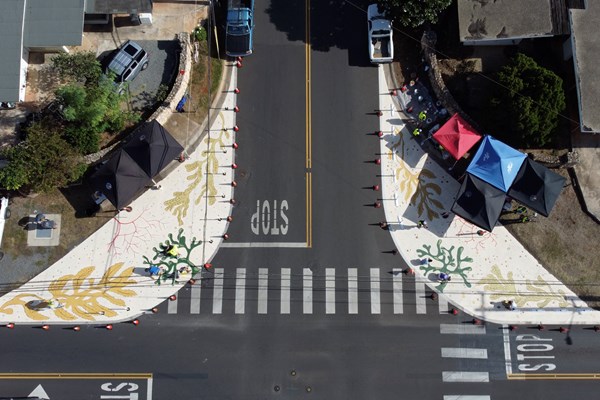Quick-builds: How small changes create more walkable communities
May 25, 2021

Many talk about the day when more transportation options exist for our community members and the changes that can then happen—more walking, connected communities, and convenient options. But why wait? It may be surprising to some that Oahu already has approximately 70,000 daily bus riders in 2021, and 43% of households own one car or less according to the U.S. Census 2018 American Community Survey. Our community can embrace these options now and make them even better.
Ulupono Initiative believes all of us deserve safe, pedestrian-friendly spaces designed with people in mind, rather than prioritizing cars. That’s why we have partnered with communities and multiple like-minded groups in Ewa Beach, Kalihi, and along Waialae Avenue in Kaimuki to further the City and County of Honolulu’s Complete Streets objectives. This partnership creates safer experiences for walking, biking, and other multimodal options, making them more desirable and likely as options for commuting. Walking is three times more common in a community with pedestrian-friendly streets than in otherwise comparable communities that are less conducive to foot travel.
Quick-build projects
This type of project uses flexible installation material such as paint and moveable traffic delineators to create safer, more accessible walking, biking and transition areas near busy intersections. These projects take, by definition, less time to plan and implement. In addition, these projects can be solutions that respond to our transportation problems now, not 10 years from now. They are also able to be changed, meaning the communities can co-create the solutions they need with other partners and government agencies. These projects get solutions on the ground now and are a new model for meeting community needs dynamically.
For example, in fall 2019, students at Farrington High School, as well as residents and various community groups in Kalihi, called for a series of quick-build projects in their neighborhood. The need to enhance pedestrian safety near the school was clear. Over a 10-year period, more than 40 motor vehicle accidents had occurred on nearby roadways.
The Kalihi Quick-Build Project—through coordination with Farrington High School, Blue Zones Project Hawaii, the U.S. National Park Service, the office of former Honolulu City Councilmember Joey Manahan, and Ulupono Initiative—created six painted curb extensions on King Street near Farrington High School, which helped reduce pedestrian street-crossing distances by 15-40% and walk time by 15-20%. The extensions were embraced by students and kupuna, allowing them to feel safer on their walking commutes.
More recently, the Papipi Quick-Build Project, located at the corner of Papipi Road and Hailipo Street/Kapolei Parkway in Ewa Beach, was developed through a partnership with Blue Zones Project: Kapolei-Ewa, Coalition for a Drug-Free Hawaii, LITT Designs, Jeff Pagay Fine Art, AARP and Ulupono Initiative, to support the community's Complete Streets initiative serving 14,000 nearby residents. The project served the City’s Safe Routes to School objective to provide a safe route for the 800-plus students who walked to Ewa Beach Elementary School daily before the onset of the COVID-19 pandemic. It also incorporated vibrant, culturally grounded artwork and high-impact curb extensions and delineators that prompted the City to mark a crosswalk to the city bus stop. The project’s most striking features are its beautiful limu murals—designed by local artists Jeff Pagay, Jim Lynn and Patrick Cullen—spotlighting the rich history and culture of the Ewa Beach community, an oceanside area where limu was once farmed.
Making a difference
In addition to increasing safety, it’s no surprise that communities creating walkable areas have also seen the number of pedestrians on their sidewalks increase three-fold compared to areas less conducive to foot travel. The increase makes complete sense. If walking conditions improve in a community, more people will feel safe to walk within them.
Quick-build projects such as these are aligned with Ulupono Initiative’s clean transportation goal to reduce Hawaii’s dependence on single-occupancy vehicles running on costly imported fossil fuels, and instead increase our transition toward a cleaner, more just, multimodal transportation system. Through these projects, more Oahu residents are walking, vehicular traffic is reduced, and the prevalence of cars in Hawaii's outdoor spaces is lessened. This drives down fuel emissions, automobile accidents involving pedestrians, and other negative costs and trade-offs.
More than 90 community volunteers gave their time in Ewa Beach to help make the Papipi Quick-Build Project a reality, including residents who lived nearby or were just passing by. For the Kalihi Quick-Build Project, Farrington High School students provided valuable insight detailing their experiences of feeling unsafe—even in a community where many people walk—due to the frequency of pedestrian-involved traffic incidents.
Other communities, such as Makiki near Robert Louis Stevenson Middle School, are recognizing the value of quick-builds and taking steps to implement them in their neighborhoods. Check back for news and updates on this and other quick-builds across the islands. When invested residents work together around a shared goal, large-scale community-led efforts like quick-build projects can be successful. Everyone in the involved communities is invited to have a role in these projects and share their thoughts and insights, which collectively prove helpful.
Learn more about the Papipi Street Quick-Build in this recent HI Now segment: Quick Builds: High-Impact, Low-Cost, No-Brainer

